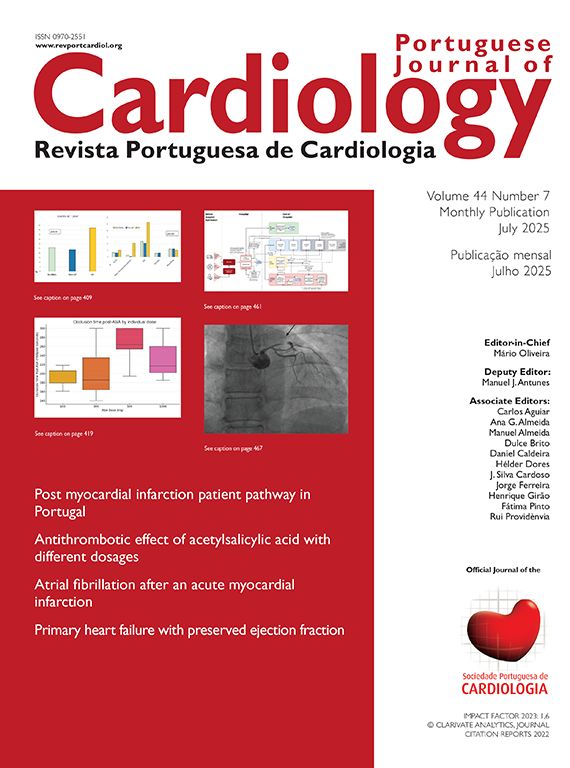In patients with chronic thromboembolic pulmonary hypertension (CTEPH), pulmonary endarterectomy (PEA) is usually the treatment of choice. It leads to improvements in cardiopulmonary hemodynamics, exercise tolerance and quality of life, particularly when performed at experienced centers.1 Previous studies have reported residual or persistent PH after CTEPH as a common finding, affecting 25–30% of patients after PEA.2 In these cases, other strategies, such as ballon pulmonary angioplasty and arterial PH-specific medication are additional treatment options.1 The diagnosis of residual PH is usually made by right heart catheterization, performed three to six months after surgery, when mean pulmonary artery pressure ≥25–30 mmHg is present.1 The explanation for this outcome is not yet completely understood. Age and preoperative mean pulmonary artery pressure are associated with the risk of residual PH,2 as well as the location of thrombotic material – distal disease, from mid-segmental and subsegmental branches (type III – University of California–San Diego surgical classification), is more challenging for the surgeon, leading in some cases to incomplete removal of the clot.3 It may also be caused by concomitant small-vessel disease in patients with operable proximal disease.3 Therefore, the main causes for persistence of PH after PEA are pulmonary microvascular disease, failure to remove fibrotic material from the pulmonary vascular tree or both. In addition, thrombus histopathology might be another cause: mixed thrombus organization, in other words, a thrombus that combines organized and organizing characteristics, is associated with lower odds for residual PH.4
The use of non-invasive methods, particularly before surgery, to identify the possibility of this outcome, would be of the utmost importance, enabling additional research on how to prevent it.
In the current issue of the journal, Luz et al. report a retrospective, observational and single center study in 39 patients who underwent PEA due to CTEPH.5 All patients had a right heart catheterization six to twelve months after surgery to exclude residual PH (defined by a mean pulmonary artery pressure ≥30 mmHg), and which was present in 46% of the patients. These patients had higher NTproBNP levels and lower six-minute walking test distance and diffusing lung capacity of carbon monoxide (DLCO). Regarding right heart structure and function at baseline (before PEA), by transthoracic echocardiography, there were also some distinct differences, particularly in tricuspid annular plane systolic excursion (TAPSE), end-diastolic right ventricular (RV) area, end-systolic RV area, RV fractional area change, TAPSE/pulmonary artery systolic pressure ratio, diastolic and systolic eccentric ratio. Independent predictors of residual PH were end-systolic RV area and end-diastolic RV area. In addition, an end-diastolic RV area >27.13 cm2 and end-systolic RV area >19.54 cm2 showed a good predictive accuracy for the development of residual PH after PEA. They concluded that echocardiography can be used to predict the presence of residual PH after surgery. The reported findings very interesting, because this is the first analysis showing that a simple and non-invasive technique can predict this outcome with high sensitivity and specificity.
One thing that needs to be highlighted is that the rate of residual PH reported in previous studies is quite wide. It ranged from 8.2% to 41.9%, with a mean rate of around 25–30%.2,6,7 This arises as, to date, there is still some debate regarding the definition of persistent residual PH after PEA, with no established threshold values, and several cut-offs being used. Moreover, the measurement of residual/persistent PH is taken at different moments after surgery (immediately or after several months) in different studies, and postoperative right heart catheterization was not routinely performed in all patients. In the current study, the reported rate is higher (46% of the patients). Nevertheless, in more recent studies, the rates are in the same range compared to previous reports, from 37% to 48%.1,8,9 Therefore, in line with the Luz et al. study.
Baseline clinical characteristics of patients with residual PH were also similar to other studies: more frequent in older patients and with baseline lower six-minute walking test distance and DLCO.1 An earlier identification of a higher risk of residual PH, preferably before PEA, could open a research window to explore new treatment strategies to avoid this untoward outcome. In general, after PEA, there is some initial improvement in functional status and exercise capacity, but residual PH impacts negatively on long-term results.5,9 In these patients, the subsequent use of modern PH therapy with PH-targeted medicine and balloon pulmonary angioplasty can improve functional status and exercise capacity, also avoiding fatal right heart failure but not long-term mortality.9 To date, there are no successful strategies to be used before PEA. Riociguat has been used as bridging therapy before PEA in patients with high preoperative pulmonary vascular resistance. It has also demonstrated hemodynamic improvement before surgery.10 However, no additional benefits in postoperative mortality or hemodynamics (residual PH) were observed with this drug, if pulmonary microvascular disease remains.
The study from Luz et al. showed that it is possible to risk stratify patients with CTEPH before PEA and select patients that might benefit from specific interventions (yet to be demonstrated) to avoid residual PH. By using echocardiography, the process can be simple and widely accessible. Moreover, their findings suggest that worse RV function and severe RV uncoupling are associated with more severe disease. This is particularly important because it has been previously shown that even after pulmonary endarterectomy there is incomplete recovery of the RV together with impaired peripheral oxygen uptake.11 Nevertheless, the results obtained require further validation in larger cohorts and in different populations before being clinically applicable.
In addition, the authors did not test new parameters of right heart function, such as strain or tridimensional volumetric assessment of both the RV and right atrium. These could have an even higher predictive capacity. New research is warranted in this field to improve the outcome of patients with CTEPH.
Conflicts of interestThe authors have no conflicts of interest to declare.





